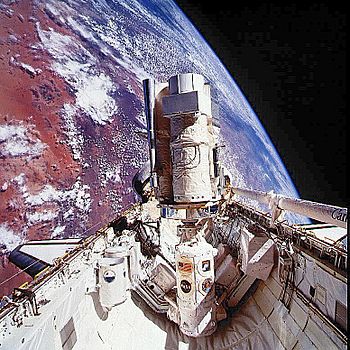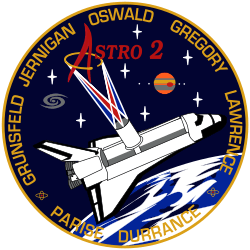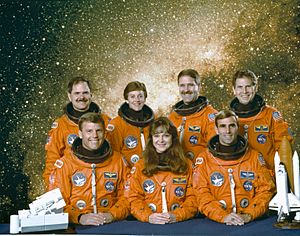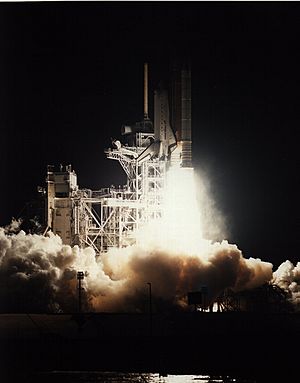STS-67 facts for kids

ASTRO-2 in Endeavour's payload bay
|
|
| Mission type | Astronomy |
|---|---|
| Operator | NASA |
| Mission duration | 16 days, 15 hours, 8 minutes, 48 seconds |
| Distance travelled | 11,100,000 kilometres (6,900,000 mi) |
| Orbits completed | 262 |
| Spacecraft properties | |
| Spacecraft | Space Shuttle Endeavour |
| Payload mass | 13,116 kilograms (28,916 lb) |
| Crew | |
| Crew size | 7 |
| Members |
|
| Start of mission | |
| Launch date | 2 March 1995, 06:38:13 UTC |
| Launch site | Kennedy LC-39A |
| End of mission | |
| Landing date | 18 March 1995, 21:47:01 UTC |
| Landing site | Edwards Runway 22 |
| Orbital parameters | |
| Reference system | Geocentric |
| Regime | Low Earth |
| Perigee | 305 kilometres (190 mi) |
| Apogee | 305 kilometres (190 mi) |
| Inclination | 28.45 degrees |
| Period | 91.5 min |
  Left to right – Front row: Oswald, Jernigan, Gregory; Back row: Parise, Lawrence, Grunsfeld, Durrance |
|
STS-67 was an exciting human spaceflight mission. It used the Space Shuttle Endeavour (also known as OV-105). The mission launched from Kennedy Space Center in Florida on March 2, 1995.
This mission lasted for over 16 days. It was the longest flight for the Space Shuttle Endeavour. The main goal was to study the universe using special telescopes.
Meet the Crew of STS-67
The STS-67 mission had seven astronauts on board. They were a team of skilled pilots and scientists.
| Position | Astronaut | |
|---|---|---|
| Commander | Stephen S. Oswald Third and last spaceflight |
|
| Pilot | William G. Gregory Only spaceflight |
|
| Mission Specialist 1 | John M. Grunsfeld First spaceflight |
|
| Mission Specialist 2 | Wendy B. Lawrence First spaceflight |
|
| Mission Specialist 3 | Tamara E. Jernigan Third spaceflight |
|
| Payload Specialist 1 | Samuel T. Durrance Second and last spaceflight |
|
| Payload Specialist 2 | Ronald A. Parise Second and last spaceflight |
|
What Did STS-67 Do?
The STS-67 mission had many important tasks. Its main focus was on astronomy. The crew used special tools to look at space.
Exploring the Universe with Ultraviolet Light
A major part of STS-67 was the Astro-2 mission. This was the second time a Spacelab module was used for ultraviolet astronomy. The first was Astro-1 on STS-35.
The Astro-2 Spacelab carried three unique instruments:
- The Hopkins Ultraviolet Telescope (HUT)
- The Ultraviolet Imaging Telescope (UIT)
- The Wisconsin Ultraviolet Photo-Polarimeter Experiment (WUPPE)
These instruments studied objects both inside and outside our solar system. They looked at stars, nebulae, galaxies, and more. The data collected added to what was learned from the Astro-1 mission.
Why Ultraviolet Light?
The Ultraviolet Imaging Telescope (UIT) was very important. It observed ultraviolet (UV) light from space. Most UV light cannot be seen from Earth. This is because our atmosphere blocks it.
The UIT from Astro-1 gave scientists their first good look at UV data from the universe. The UIT on Astro-2 was even better. It could capture almost twice as much UV light. Also, STS-67 launched at a different time of year. This allowed it to view parts of the sky that Astro-1 could not see.
Experiments on the Middeck
The mission also included several science experiments in the Middeck area. These experiments covered different fields of study.
One interesting experiment was the Middeck Active Control Experiment (MACE). This was a space engineering project. It tested a system to control motion disturbances. Imagine trying to take a clear picture on a shaky boat. MACE helped design systems to keep spacecraft steady.
Commander Stephen S. Oswald and Pilot William G. Gregory worked on MACE. They tested about 200 different motion situations. This testing lasted for 45 hours during the mission. The information from MACE helps engineers build better spacecraft. These new spacecraft will be more stable in space.
Special Payloads on Board
The Endeavour also carried two "Get Away Special" (GAS) payloads. These were special containers for small experiments. They were named G-387 and G-388.
These experiments were sponsored by Australia. Their goal was to observe deep space and nearby galaxies in ultraviolet light. Scientists wanted to study things like supernova remnants and hot gas clouds.
One GAS canister had a special door. When opened, it let a UV telescope look out into space. The other canister held video recorders for data and batteries for power.
Mission Insignia
The mission patch for STS-67 tells a story. It shows a spiral galaxy, Jupiter, and four of its moons. These six space objects, along with seven stars, represent the mission's number (STS-67). The Space Shuttle Endeavour, carrying the ASTRO-2 lab, is shown speeding by.


